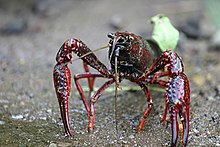
Back كركنديات المياه العذبة Arabic كركنديات المياة العذبه ARZ Cambaridae CEB Инçет Хĕвелтухаç юханшыв ракĕ CV Cambaridae German Cambaridae Spanish Cambaridae French Cambaridae Icelandic Cambaridae Italian アメリカザリガニ科 Japanese
| Cambaridae Temporal range:
| |
|---|---|

| |
| Procambarus clarkii | |
| Scientific classification | |
| Domain: | Eukaryota |
| Kingdom: | Animalia |
| Phylum: | Arthropoda |
| Class: | Malacostraca |
| Order: | Decapoda |
| Suborder: | Pleocyemata |
| Superfamily: | Astacoidea |
| Family: | Cambaridae Hobbs, 1942 |
| Genera | |
| |
The Cambaridae are the largest of the four families of freshwater crayfish, with over 400 species.[1] Most of the species in the family are native to the United States east of the Great Divide and Mexico, but fewer range north to Canada, and south to Guatemala and Honduras. Three live on the island of Cuba. The species in the genus Cambaroides are only found outside North America, as they are restricted to eastern Asia.[2]
A few species, including the invasive Procambarus clarkii and Faxonius rusticus, have been introduced to regions far outside their native range (both in North America and other continents). Conversely, many species have tiny ranges and are seriously threatened; a few are already extinct.[2]
A 2006 molecular study suggested that the family Cambaridae may be paraphyletic, with the family Astacidae nested within it, and the status of the genus Cambaroides remains unclear.[3]
The oldest fossils of the family are known from the Late Jurassic Morrison Formation of western North America.[4]
- ^ James W. Fetzner Jr. (2005-05-09). "Family Cambaridae Hobbs, 1942". Crayfish Taxon Browser. Carnegie Museum of Natural History. Archived from the original on 2014-02-03. Retrieved 2007-08-20.
- ^ a b T. Kawai; Z. Faulkes; G. Scholtz, eds. (2015). Freshwater Crayfish: A Global Overview. CRC Press. ISBN 9781466586390.
- ^ A. Braband, T. Kawai & G. Scholtz (2006). "The phylogenetic position of the East Asian freshwater crayfish Cambaroides within the Northern Hemisphere Astacoidea (Crustacea, Decapoda, Astacida) based on molecular data". Journal of Zoological Systematics and Evolutionary Research. 44 (1): 17–24. doi:10.1111/j.1439-0469.2005.00338.x.
- ^ Audo, Denis; Hasiotis, Stephen T; Kawai, Tadashi (2023-12-01). "Diversity and evolutionary history of fossil crayfishes". Journal of Crustacean Biology. 43 (4). doi:10.1093/jcbiol/ruad079. ISSN 0278-0372.